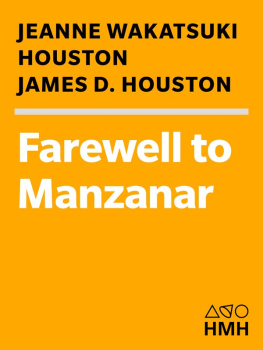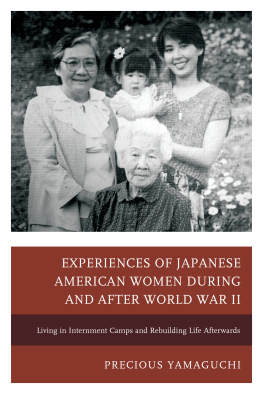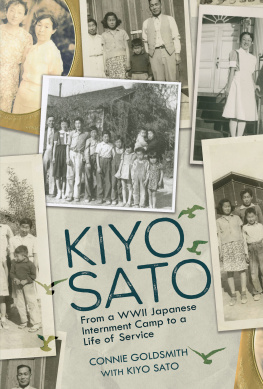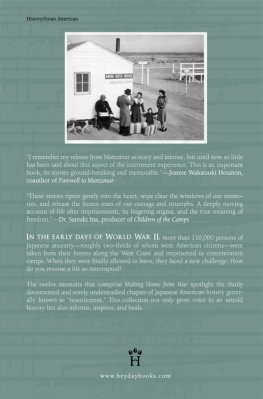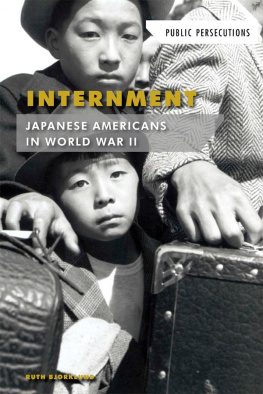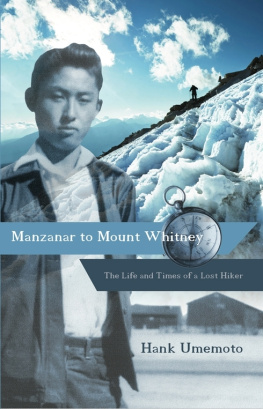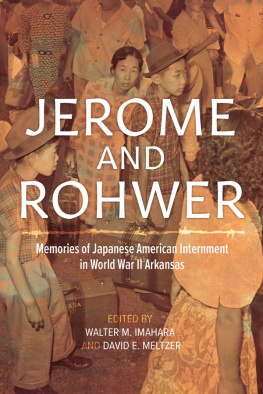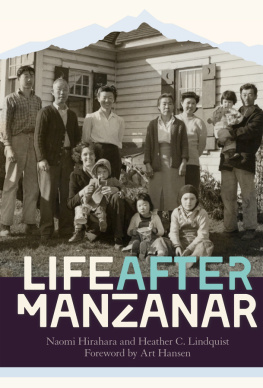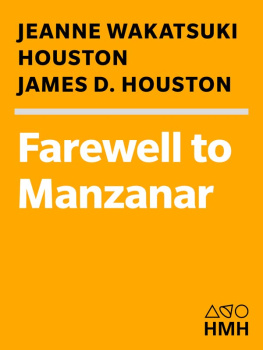Copyright 1973 by James D. Houston
Afterword copyright 2002 by Jeanne Wakatsuki Houston and James D. Houston
All rights reserved. For information about permission to reproduce selections from this book, write to Permissions, Houghton Mifflin Harcourt Publishing Company, 215 Park Avenue South, New York, New York 10003.
www.hmhco.com
The Library of Congress has cataloged the print edition as follows:
Houston, Jeanne Wakatsuki.
Farewell to Manzanar.
1. Houston, Jeanne Wakatsuki. 2. United States. War Relocation Center, Manzanar, Calif. 3. Japanese in the United States. I. Houston, James D., joint author. II. Title.
ISBN 0-618-21620-0
E184.J3H63 940.54'72'73
73-11267
For permission to reprint copyrighted material the authors are grateful to the publishers and copyright proprietors.
Dont Fence Me In (from Hollywood Canteen)
Words and Music by COLE PORTER
Copyright 1944 (Renewed) WB MUSIC CORP.
All Rights Reserved Used by Permission
Girl of My Dreams
Words and Music by SUNNY CLAPP
Copyright 1927 (Renewed 1955) EMI MILLS MUSIC, INC.
All Rights Controlled by EMI MILLS MUSIC, INC. (Publishing) and ALFRED PUBLISHING CO., INC. (Print)
All Rights Reserved Used By Permission
Excerpt from Viet Nam Poems, reprinted from Call Me By My True Names (1999) by Thich Nhat Hanh with permission from Parallax Press, Berkeley, California.
www.parallax.org
eISBN 978-0-547-52861-8
v3.0215
to the memory of
Ko and Riku Wakatsuki
and Woodrow M. Wakatsuki
Foreword
When we first considered writing a book about the internment of Japanese Americans during World War Two, we told a New York writer friend about the idea. He said, Its a dead issue. These days you can hardly get people to read about a live issue. People are issued out.
I know it, my husband said. Im issued out myself. The issue isnt what we want to write about. Everybody knows an injustice was done. How many know what actually went on inside? If they think anything, they think concentration camps. But that conjures up Poland and Siberia. And these camps werent like that at all.
So we set out to write about the life inside one of those campsManzanarwhere my family spent three and a half years. We began with a tape recorder and an old 1944 yearbook put together at Manzanar High School. It documented the entire camp scenethe graduating seniors, the guard towers, the Judo pavilion, the creeks I used to wade in, my familys barracks. As the photos brought that world back, I began to dredge up feelings that had lain submerged since the forties. I began to make connections I had previously been afraid to see. It had taken me twenty-five years to reach the point where I could talk openly about Manzanar, and the more I talked, the clearer it became that any book we wrote would have to include a good deal more than day-to-day life inside the compound. To tell what I knew and felt about it would mean telling something about our family before the war, and the years that followed the war, and about my fathers past, as well as my own way of seeing things now. Writing it has been a way of coming to terms with the impact these years have had on my entire life.
To complete this book we have had to rely on a good deal besides my own recollections. Many people helped make it possible, more than we can name here. We are especially grateful to all the members of the family who shared their memories, and to these friends: Jack and Mary Takayanagi, Don Tanzawa, and Mary Duffield. We are indebted to the numerous writers and researchers whose works have been indispensable to our own perspective on the period. And we thank the University of California at Santa Cruz for a research grant that made it possible to begin.
Because this is a true story, involving an extraordinary episode in American history, we have included a list of dates and laws we hope will make it easier to follow. It needs some historical context. But this is not political history. It is a story, or a web of storiesmy own, my fathers, my familystracing a few paths, out of the multitude of paths that led up to and away from the experience of the internment.
Jeanne Wakatsuki Houston, Santa Cruz, California, March 1973
A Chronology
1869 The first Japanese to settle on the U.S. mainland arrive at Gold Hill, near Sacramento, California.
1870 U.S. Congress grants naturalization rights to free whites and people of African descent, omitting mention of Asian races.
1886 The Japanese government lifts its ban on emigration, allowing its citizens for the first time to make permanent moves to other countries.
1911 U.S. Bureau of Immigration and Naturalization orders that declarations of intent to file for citizenship can only be received from whites and from people of African descent, thus allowing courts to refuse naturalization to the Japanese.
1913 Alien Land Bill prevents Japanese aliens from owning land in California.
1924 Congress passes an Immigration Act stating that no alien ineligible for citizenship shall be admitted to the U.S. This stops all immigration from Japan.
December 7, 1941 Surprise attack on Pearl Harbor by the Japanese.
February 19, 1942 President Roosevelt signs Executive Order 9066, giving the War Department authority to define military areas in the western states and to exclude from them anyone who might threaten the war effort.
March 25, 1942 Evacuees begin to arrive at Manzanar Camp, in Owens Valley, California, the first of the permanent camps to open.
August 12, 1942 Evacuation completed, 110,000 people of Japanese ancestry removed from the West Coast to ten inland camps.
December 18, 1944 U.S. Supreme Court rules that loyal citizens cannot be held in detention camps against their will, the first major step toward the closing of the camps.
August 14, 1945 Japan surrenders, ending World War II.
November 21, 1945 Manzanar Camp officially closes.
June 1952 Congress passes Public Law 414, granting Japanese aliens the right to become naturalized U.S. citizens.
Terms Used in This Book
Issei The first generation. The Issei were born in Japan. Most of them immigrated to the United States between 1890 and 1915.
Nisei The second generation, the children of the Issei. American citizens by birth, almost all Nisei were born before the Second World War.
Sansei The third generation of Americans with Japanese ancestry, most of them born during or after the Second World War.
It is sobering to recall that though the Japanese relocation program, carried through at such incalculable cost in misery and tragedy, was justified on the ground that the Japanese were potentially disloyal, the record does not disclose a single case of Japanese disloyalty or sabotage during the whole war...
Henry Steele Commager, Harpers Magazine, 1947
Life has left her footprints on my forehead
But I have become a child again this morning
The smile, seen through leaves and flowers, is back,
to smooth
Away the wrinkles
As the rains wipe away footprints on the beach. Again a
Cycle of birth and death begins.
Thich Nhat Hanh, Viet Nam Poems, 1967
Part 1
one
What Is Pearl Harbor?
O N THAT FIRST WEEKEND IN D ECEMBER THERE must have been twenty or twenty-five boats getting ready to leave. I had just turned seven. I remember it was Sunday because I was out of school, which meant I could go down to the wharf and watch. In those days1941there was no smog around Long Beach. The water was clean, the sky a sharp Sunday blue, with all the engines of that white sardine fleet puttering up into it, and a lot of yelling, especially around Papas boat. Papa loved to give orders. He had attended military school in Japan until the age of seventeen, and part of him never got over that. My oldest brothers, Bill and Woody, were his crew. They would have to check the nets again, and check the fuel tanks again, and run back to the grocery store for some more cigarettes, and then somehow everything had been done, and they were easing away from the wharf, joining the line of boats heading out past the lighthouse, into the harbor.
Next page
